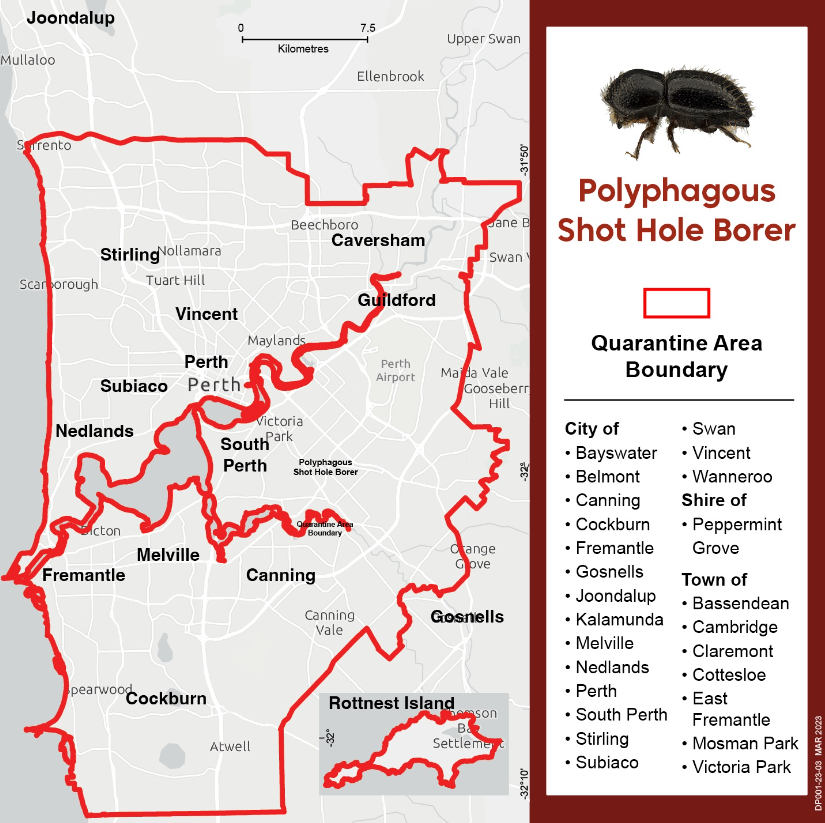The City of Nedlands is working closely with the Department of Primary Industries and Regional Development’s (DPIRD) to help stop the spread of Polyphagous shot-hole borer (PSHB).
What is PSHB?
Polyphagous shot-hole borer (PSHB) Euwallacea fornicatus is a beetle native to Southeast Asia. The beetle attacks a broad variety of trees by tunnelling into their trunks, stems, and branches. PSHB has a close relationship with a Fusarium fungus, which it cultivates inside the tree to provide food for the beetle and its larvae. In vulnerable trees, the fungus destroys vascular tissue, resulting in dieback and tree mortality, with trees quickly becoming safety hazards due to falling branches.
There are no known effective chemical treatments for PSHB; therefore, early diagnosis and immediate removal or pruning of affected trees is critical to limiting PSHB spread and reducing future effects on surrounding trees. Only after the issuance of a Pest Control Notice (PCN) can DPIRD provide instructions for the removal of an affected tree.
Quarantine Area
The City of Nedlands is included in DPRID’s Quarantine Area
It is important that residents within the area aware of the restrictions on the movement of wood and plant material from their properties as they could act as hosts and potentially spread the borer. PSHB does not affect grass so lawn clippings can be disposed of as normal.
Please see the Quarantine area sheet below for more information and area requirements.
PF013-22 Polyphagous shot-hole borer DL infographic_PRINT.pdf (agric.wa.gov.au)

How to detect infected trees
PSHB particularly favours the Box Elder Maple (Acer negundo). Other popular reproductive hosts (susceptible trees) include Plane (Platanus), Poplars (Populus), Oak (Quercus), Avocado (Persea), Fig (Ficus), Black Locust (Robinia), Willow (Salix), Mulberry (Morus), Poinciana (Delonix regia) and Coral Tree (Erythrina).
A list of host tree species in WA where the beetles have successfully reproduced is accessible via www.agric.wa.gov.au/sites/gateway/files/PSHB-WA-Host-List.pdf.
Common signs to look for include:
- Beetle entry/exit holes - approximately the size of a ballpoint pen tip.
- Galleries - when pruning branches or inspecting fallen branches, check for evidence of galleries caused by the tunnelling action of PSHB beetles.
- Discoloration/staining - this is caused by the Fusarium fungus.
- Gumming - thick resin or sap.
- Frass - produced by the beetles tunnelling, frass may be seen on the tree exterior. This can indicate a high level of infestation.
- Sugar volcanoes - crystalline foam is exuded from entry/exit holes.
- Dieback and tree death - the fungus disrupts the tree vascular symptom causing dieback and death.
How to report
Residents are encouraged to inspect backyard trees for suspected borer damage and should report to DPIRD’s Pest and Disease Information Service on (08) 9368 3080, email padis@dpird.wa.gov.au or via the MyPestGuide Reporter app. For more information on PSHB visit www.agric.wa.gov.au/borer